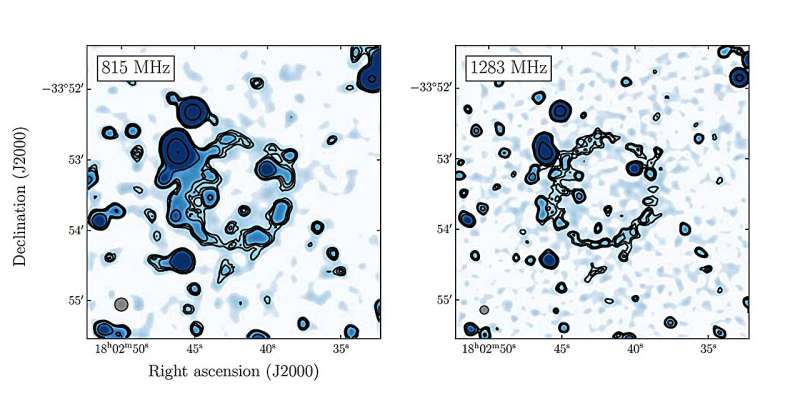August 21, 2024 report
This article has been reviewed according to Science X's editorial process and policies. Editors have highlighted the following attributes while ensuring the content's credibility:
fact-checked
peer-reviewed publication
trusted source
proofread
MeerKAT observations detect a mysterious faint radio ring

An international team of astronomers reports a serendipitous discovery of a new radio ring toward the Galactic center. The newfound object is relatively faint and its true nature is yet unknown. The finding was reported in a research paper forthcoming in the Astronomy & Astrophysics journal.
Recent wide area radio continuum surveys have revealed the presence of low surface brightness ring-like radio sources, often associated with the late phases of stellar evolution. These so-called odd radio circles (ORCs) are in general mysterious gigantic rings of radio waves and their origin is still unexplained.
Now, a new source of this type, which resembles an ORC, has been found by a group of astronomers led by Cristobal Bordiu of the Catania Observatory in Italy. The source, designated J1802–3353 and dubbed Kýklos (meaning "circle" in Greek), was detected with the MeerKAT radio telescope.
"We present the serendipitous discovery of a new radio-continuum ring-like object nicknamed Kýklos (J1802–3353), with MeerKAT UHF and L-band observations," the researchers wrote in the paper.
Kýklos was identified by Bordiu's team about 6.0 degrees from the Galactic plane and close (in projection) to the Galactic center. The object has a diameter of approximately 80 arcseconds and a thickness of about six arcseconds.
In MeerKAT total intensity maps, Kýklos appears as a faint ring-like structure, clumpy and nearly circular. The ring's appearance resembles a limb-brightened shell, with the interior devoid of detectable emissions.
Morphologically, Kýklos resembles an odd radio circle. However, it is located at a much lower Galactic latitude than the known ORCs. Moreover, it is also one order of magnitude fainter at 1.0 GHz and has a much flatter spectral index when compared to the population of detected ORCs.
Therefore, the astronomers take into account several other hypotheses that could explain the nature of Kýklos: a Galactic supernova remnant, a planetary nebula, a nova remnant, and a circumstellar shell around an evolved massive star.
Based on the analysis of collected data, the authors of the paper concluded that Kýklos being a circumstellar shell around, possibly, a Wolf-Rayet (WR) star, is the most plausible scenario.
"Based on the limited data currently available, the morphological and spectral characteristics of Kýklos appear more consistent with those of a WR shell. This interpretation is further supported by the absence of a detectable central point source in the L-band image," the scientists explained.
Follow-up multiwavelength observations are required in order to fully characterize Kýklos and to identify a possible central source, which could confirm the WR shell hypothesis.
More information: Cristobal Bordiu et al., MeerKAT reveals a ghostly thermal radio ring towards the Galactic Centre, Astronomy & Astrophysics (2024). DOI: 10.1051/0004-6361/202450766. On arXiv: DOI: 10.48550/arxiv.2408.07727
Journal information: arXiv , Astronomy & Astrophysics
© 2024 Science X Network





















